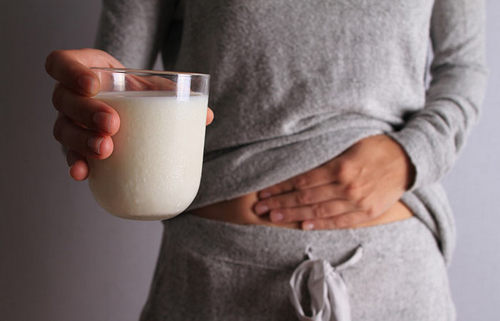Statistics by the National Institute of Health show that about 70 million people in the US alone suffer from some digestive disease every year. You don’t want to be one of them, do you?
This is where kefir comes into the picture. A cultured dairy, kefir is one of the most probiotic-rich foods on the planet.
It contains far more friendly bacteria than your regular yogurt. And it is bound to boost your health in several ways. Just keep reading to know how.
You want to be healthy and live long, don’t you? But did you know all of that depends on your gut health? Take care of your gut – and it will take very good care of you. Because when it comes to your gut, it’s serious business.
What’s Kefir?
Kefir is a sour-tasting drink that is made by fermenting bacteria and yeast in cow milk. This combination of bacteria and yeast is called kefir grain. Unlike typical grains (like rice or wheat), kefir grain doesn’t contain gluten. It is combined with milk and stored in a warm area to culture, and what you get is the kefir beverage.
Kefir is available in different types – milk kefir (made from the milk of cows or goats or of coconut) and water kefir (made from sugary or coconut water). And most of the benefits of kefir can be attributed to its incredible probiotic content. Let’s take a look at the benefits.
What Are The Benefits Of Kefir?
1. Boosts Digestive Health
The probiotics in the drink explain it. Kefir restores the balance of friendly bacteria in the gut, and this boosts digestive health like nothing else. Studies show how probiotics can even treat most forms of diarrhea.

Research also tells us how they can help treat numerous other digestive ailments, some of which include irritable bowel syndrome, ulcers, and H.pylori infection.
The probiotics in kefir also help treat acid reflux.
2. Kefir Improves Bone Health
Kefir is replete with calcium and vitamin K2, both of which contribute to bone health. Studies show how adequate calcium can improve bone health and prevent the onset of osteoporosis. Osteoporosis happens when the bone tissue deteriorates – but calcium and vitamin K2 can prevent this.
Kefir can also enhance calcium absorption by the bone cells – which results in improved bone density and reduced risk of fractures.
3. Can Aid Weight Loss
Low-fat kefir can help in this regard. Kefir also is rich in protein, a nutrient that can keep you satiated and stop you from binge eating. Though more research is warranted, some studies show how probiotics can promote healthy weight loss.
The way probiotics influence gut bacteria impacts appetite and digestion – and this also can have some beneficial effects on weight loss.
4. May Prevent Cancer
Compounds in kefir can make the cancer cells self-destruct – and this is especially true with regard to gastric cancer.
Other bioactive compounds in kefir, like peptides, polysaccharides, and sphingolipids, also help prevent cancer. These compounds induce cancer cell death.
When compared to yogurt, kefir fares far better in preventing cancer. One study showed how kefir extract reduced the number of human breast cancer cells by as much as 56%, as opposed to the 14% by the yogurt extract (7).
5. Boosts Immunity
The biotin and folate in kefir boost the immune system. Even the probiotics in kefir do a great job here. For example, Lactobacillus Kefiri, a particular strain of probiotics in kefir, protect your body against salmonella and E.Coli, some very harmful bacteria.
Thanks to the anti-inflammatory properties of kefir, this drink also helps prevent allergies and asthma.
6. Helps Lower Blood Sugar
Though more research is warranted, one Iranian study shows how kefir can be used to lower blood sugar levels. The study concludes by saying kefir could be an alternative treatment for diabetes.
7. Can Lower Cholesterol Levels
One study showed how women who drank low-fat kefir for eight weeks saw a significant decline in their bad cholesterol levels. Though we need more research, experts conclude that the probiotics in kefir influence how much cholesterol the body can absorb from food.
8. Good For Those With Lactose Intolerance
Lactose intolerance occurs when the body cannot digest the lactose present in dairy products (due to insufficient lactase in the body, which it needs to digest lactose). But the probiotics in kefir play a role here – they help digest the lactose. This eventually helps boost lactose tolerance.

One American study also shows us how kefir can be used as a potential treatment for lactose intolerance.
9. Could Be Beneficial During Pregnancy
We have limited research here as well. Though the probiotics in kefir help prevent infections like bacterial vaginosis, we don’t know yet if they can be beneficial to pregnant women or babies in any way.
10. Kefir Can Boost Skin Health
Did you know there is a connection between your gut health and skin condition? Gut issues can also manifest in the form of rashes, acne, psoriasis, and eczema. Kefir restores the good gut bacteria, and this enhances skin health as well.
Kefir also contains a carbohydrate called kefiran that improves the pace and quality of skin wound healing. It even protects the connective tissue.
These are the ways kefir can make your life easier. But hold on – what’s the big deal between kefir and yogurt? Only that kefir contains more probiotics, right?
Wrong. Not just that.
Kefir Vs. Yogurt – Which Is Better?
The most significant difference is the types of probiotics each contains. While yogurt contains 2 to 7 types of good bacteria strains, kefir contains 10 to 34 good bacteria strains, in addition to beneficial yeast strains.
Another difference is that yogurt contains transient bacteria, which clean and line the gut and offer food to the good bacteria. This means these bacteria don’t stay in the gut. But kefir bacteria attack the gut walls and colonize. They stay back and regulate the gut. They also are aggressive – they can go out of their way and attack the pathogens and other bad bacteria in your gut.
Talking about consistency, yogurt is thicker while kefir is thinner. And while yogurt is made by heating milk and adding a bacteria starter, kefir is made of kefir grains that are added at room temperature.
So, which of the two is better? Kefir, isn’t it? How do you get it? We recommend you prepare it at home. That way, you get the healthier version of the power probiotic, and you can save some money as well!
How To Prepare Kefir At Home
The process is simple.
- Add 1 to 2 tablespoons of kefir grains (you can get them here) to a small jar.
- Add about 2 cups of milk (organic or raw; milk from grass-fed cows work best) and leave an inch of room at the top of the jar.
- You can also add some full-fat cream if you want a thicker consistency.
- Put the lid on and leave the jar undisturbed for 12 to 36 hours at room temperature.
- When it starts to look clumpy, it is ready.
You can again strain out the liquid, and what is left behind are the original kefir grains. Repeat the process for more kefir.
In addition to probiotics, 200 grams of kefir also contains 11 grams of protein (22% of the RDA), 10 grams of fat (15% of the RDA), 12 grams of total carbs (4% of the RDA), and 200 calories.
Despite all the rosy stuff, there is something you need to keep in mind.
What Are The Side Effects Of Kefir?
- Issues During Pregnancy And Breastfeeding
Though kefir may help fight bacterial vaginosis, information is incomplete. Hence, stay safe and avoid its use if you are pregnant or nursing.
- A Weakened Immune System
Kefir boosts immunity. If you are someone with conditions that weaken the immune system (like AIDS), consuming kefir might cause infections due to the presence of bacteria and yeast.
- Colon Cancer
Individuals undergoing chemotherapy for colon cancer must stay away from kefir – or they may experience side effects like mouth sores, drowsiness, sweats, hair loss, and even intestinal issues.
Conclusion
As we said, it all resides in your gut. Take care of your gut, and it will take care of you. Start having kefir today!
Tell us how this post has helped you by leaving a comment in the box below.
Expert’s Answers for Readers Questions
How much kefir can I drink?
Start small. You can go with 1 to 4 cups of kefir a day.
Is kefir lactose-free?
Yes. In fact, the bacteria it contains help digest the lactose.
How to tell if kefir has gone bad?
The best way to check is to go with the color. If kefir starts changing color, from creamy white to greenish blue or orange, it has gone bad. Just throw the product away.



